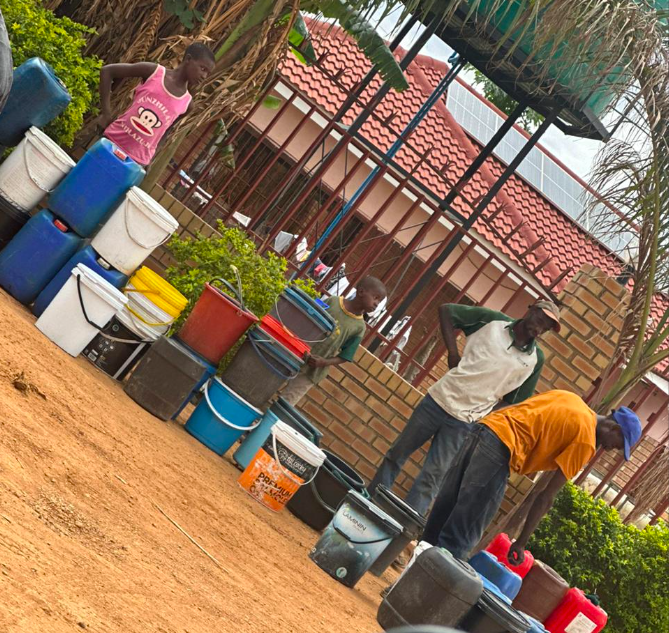

The Water and Electricity Crisis in Zimbabwe: A Struggle for Survival. In Zimbabwe, particularly in towns like Kadoma and its surrounding areas, the struggle for access to basic services like electricity and water has become a daily reality for millions of people. The country is grappling with chronic power outages, commonly known as “load shedding,” and severe water shortages, both of which are severely disrupting daily life. These issues have reached a critical point where many residents, especially in urban and peri-urban areas, are struggling to meet even their most basic needs.
Water and Electricity Crisis: A Harsh New Normal
Power cuts in Zimbabwe have become an almost constant feature of daily life, with electricity outages often lasting up to 18 hours a day. For residents of Kadoma and neighboring areas, this has led to significant disruptions in both personal and professional life. The loss of electricity means no lights, refrigeration, or functioning appliances, forcing people to find alternative ways to cope.
Businesses across the country have borne the brunt of these outages, particularly those in the manufacturing, agricultural, and mining sectors. Small enterprises, such as shops, food vendors, and service providers, are struggling to stay afloat, as power cuts prevent them from operating their equipment or running their businesses. Larger industries, especially those in the mining sector—a key contributor to Zimbabwe’s economy—are losing millions of dollars in productivity every month due to frequent power interruptions.
The root cause of the crisis lies with the country’s power utility, ZESA (Zimbabwe Electricity Supply Authority). Despite the severe power shortages, ZESA has the capacity to provide more reliable electricity. However, corruption, mismanagement, and outdated infrastructure within the utility have hampered its ability to deliver consistent power. The result is a persistent cycle of unreliable electricity, with no clear solution in sight.
Water and Electricity Shortages: A Crisis of Access and Equity
While the power outages are severe, the water shortages facing residents of Kadoma and other parts of Zimbabwe are equally devastating. In many areas, taps can run dry for up to a week, leaving people scrambling to find water for daily consumption, cooking, and cleaning. This problem is especially pronounced in low-income and informal settlements, where access to clean, reliable water is a luxury that many cannot afford.

In response to the crisis, some residents with boreholes have begun selling water to neighbors. For $1 USD, they offer six buckets of water—a rate that only those with financial means can afford. This has turned water into a commodity, creating a divide between those who can pay and those who cannot. At the same time, some well-meaning residents, understanding the plight of their neighbors, have set up taps outside their homes to allow others to access water from their boreholes free of charge. These acts of solidarity provide a much-needed lifeline to the community, though they remain the exception rather than the rule.
The Gendered Burden: Women and Girls Carrying the Load
The water and electricity crises in Zimbabwe disproportionately affect women and girls. Traditionally, women are the primary caregivers in the household, responsible for cooking, cleaning, washing, and childcare. In rural areas, this responsibility also includes walking long distances to fetch water and firewood. For women and girls in urban areas like Kadoma, the situation has become increasingly dire.
In some low-density suburbs, women can be seen queuing for hours, sometimes until midnight, just to collect water for the next day. In some cases, large containers of water are left by the roadside or outside school gates overnight, in the hope that they will be filled by the morning. These long hours spent in search of water leave women with little time for other essential activities, such as education or paid work.
For young girls, the burden is particularly heavy. Time spent walking for water means less time for schoolwork, resulting in lower academic performance. In some cases, girls are forced to stay home entirely to help with water collection, further exacerbating the gender gap in education. The lack of reliable water also affects basic hygiene and sanitation, increasing the risk of waterborne diseases, particularly among children.
The Ripple Effect on the Economy
The dual crises of power outages and water shortages have far-reaching consequences for businesses and the broader economy. In Kadoma, a town that is home to several large mining operations, power shortages have forced many companies to halt production for hours or even days. The inefficiencies in power supply have led to significant financial losses, particularly in the mining sector, which is one of Zimbabwe’s most important industries.
The water crisis further complicates the situation. Businesses, particularly in the manufacturing and service sectors, have been forced to invest in expensive backup solutions such as boreholes, water tanks, and generators just to keep running. The added cost of these measures has contributed to rising prices for goods and services, placing additional strain on Zimbabwe’s already fragile economy.
Small businesses, such as food vendors, barbershops, and hair salons, are struggling to survive in this environment. Without reliable access to water, these businesses cannot maintain basic hygiene standards, and without electricity, they cannot operate their equipment. The result is a shrinking private sector and increasing unemployment, especially in urban areas.

A Call for Accountability and Reform
The ongoing power and water crises in Zimbabwe are a stark reminder of the broader governance issues plaguing the country. While the capacity to solve these problems exists, there is a systemic failure within key utilities like ZESA and municipal water authorities. The core of this failure lies in corruption, mismanagement, and a lack of political will to address these issues at their roots.
It is imperative that Zimbabwe’s leaders and institutions take decisive action to address these challenges. Solving the energy crisis will require not just investment in infrastructure but a reform of institutions like ZESA to root out corruption and inefficiency. Similarly, the water crisis cannot be solved by simply distributing water but requires long-term investments in water infrastructure, improved management of resources, and greater transparency in local water supply systems.
Conclusion: A Community in Crisis
The power and water shortages in Kadoma and other parts of Zimbabwe are not mere inconveniences—they are critical issues that affect every aspect of life. From businesses to education, health to household chores, these crises have profound impacts on daily living. For women and girls, the burden is especially heavy, as they are forced to shoulder a disproportionate share of the work, leaving them with fewer opportunities for education, economic participation, and personal advancement.
The way forward requires a comprehensive approach—one that tackles not just the technical challenges of power generation and water distribution, but also the systemic issues of governance, corruption, and mismanagement. Until these challenges are addressed, the people of Zimbabwe will continue to endure the harsh realities of an unreliable power supply and a water crisis that leaves many struggling to survive.
Addressing these issues is not only a matter of survival but of dignity and justice for the people of Zimbabwe. The time for accountability is now.
source – zinews24
#Water #Electricity #Crisis #Zimbabwe #Struggle #Survival



